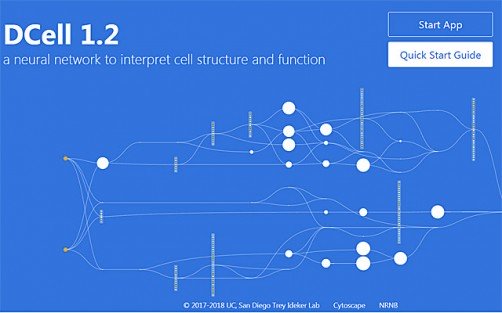
Screenshot from d-cell.ucsd.edu, where researchers can use DCell, a new virtual yeast cell developed at UC San Diego School of Medicine. Credit: UC San Diego Health
Scientists have created a virtual yeast cell model that can learn from real-world behaviors, a key step in utilizing artificial intelligence in healthcare to diagnose diseases.
A team of researchers from the University of California San Diego has developed what they called a “visible” neural network that enabled them to build DCell—a machine learning model of a functioning brewer’s yeast cell that is commonly used in basic research.
Machine learning systems are built on a neural network that consist of layers of artificial neurons that are tied together by seemingly random connections between neurons. The systems “learn” by fine-tuning those connections.
In DCell, the researchers amassed all knowledge of cell biology in one place and created a hierarchy of the cellular components.
For machine learning to be useful and trustworthy in healthcare, practitioners need to understand how a system arrives at a decision, said Trey Ideker, PhD, University of California San Diego School of Medicine and Moores Cancer Center professor, in a statement.
“It seems like every time you turn around, someone is talking about the importance of artificial intelligence and machine learning,” Ideker said. “But all of these systems are so-called ‘black boxes.’ They can be very predictive, but we don’t actually know all that much about how they work.”
DCell, said Ideker, is not a black box; the connections are not a mystery and cannot form by happenstance.
Instead, DCell’s learning is guided by real-world cellular behaviors and constraints, coded from approximately 2,500 known cellular components. The researchers input information about genes and genetic mutation, allowing the system to predict cellular behaviors like growth. DCell, which is trained on several million genotypes, found that the virtual cell could simulate cellular growth nearly as accurately as a real cell grown in a laboratory.
“Human knowledge is incomplete,” said Jianzhu Ma, PhD, an assistant research scientist who led the efforts to build DCell, said in a statement. “We want to complete that knowledge to help guide predictions, in health care and elsewhere.”
The researchers tested the new system by deliberately feeding it false information. The system was able to decipher that it was false information and refused to work.
When the researchers wired ribosomes to an unrelated process like apoptosis, DCell could no longer predict cell growth. The virtual cell “knows” that the new arrangement is not biologically possible.
The research team is now generating some of the experimental data they would need to build a DCell system for cancer and determine how to best personalize the virtual cell approach for each individual patient’s unique biology.
“We want one day to be able to input your specific cancer-related genetic mutations and get back a readout on how aggressive your cancer is, and the best therapeutic approach to prevent its growth and metastasis,” Ideker said.




